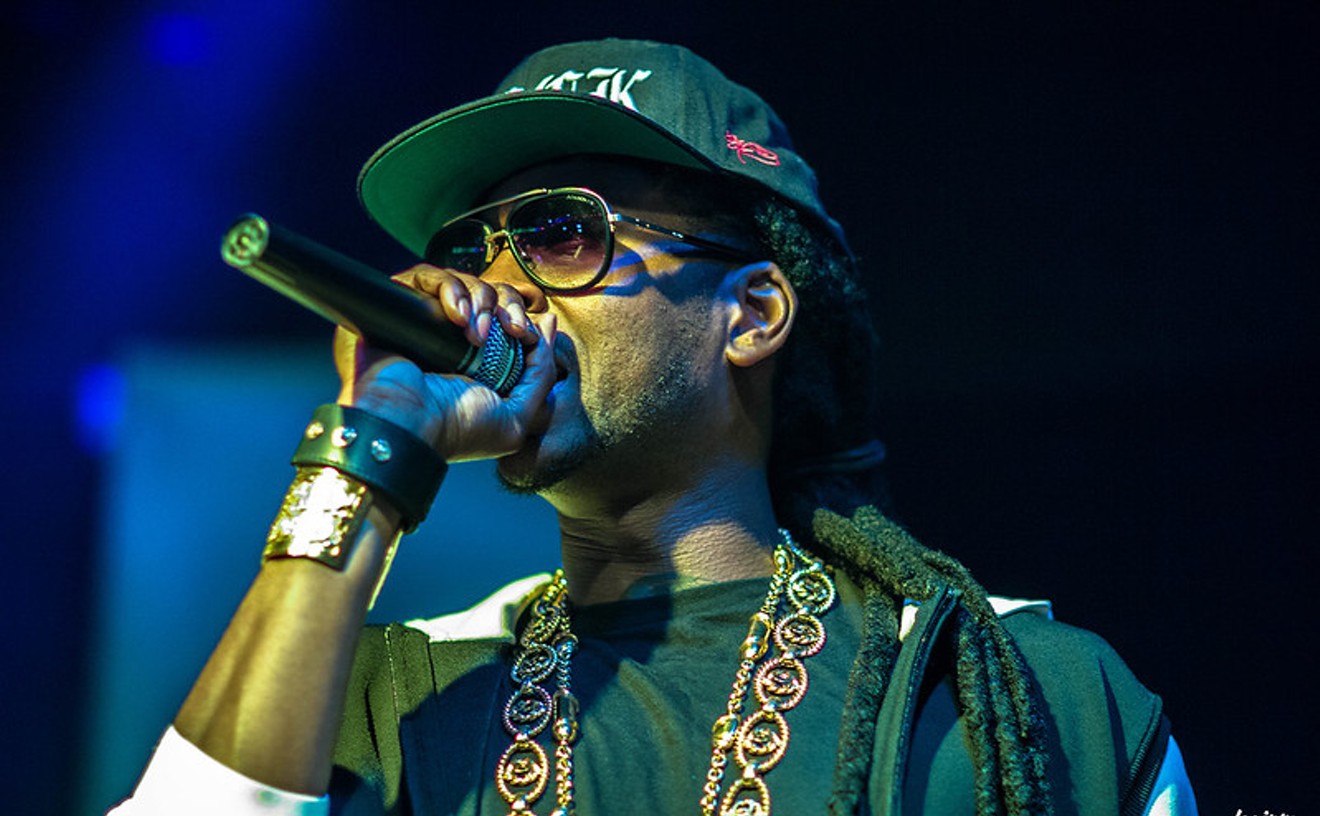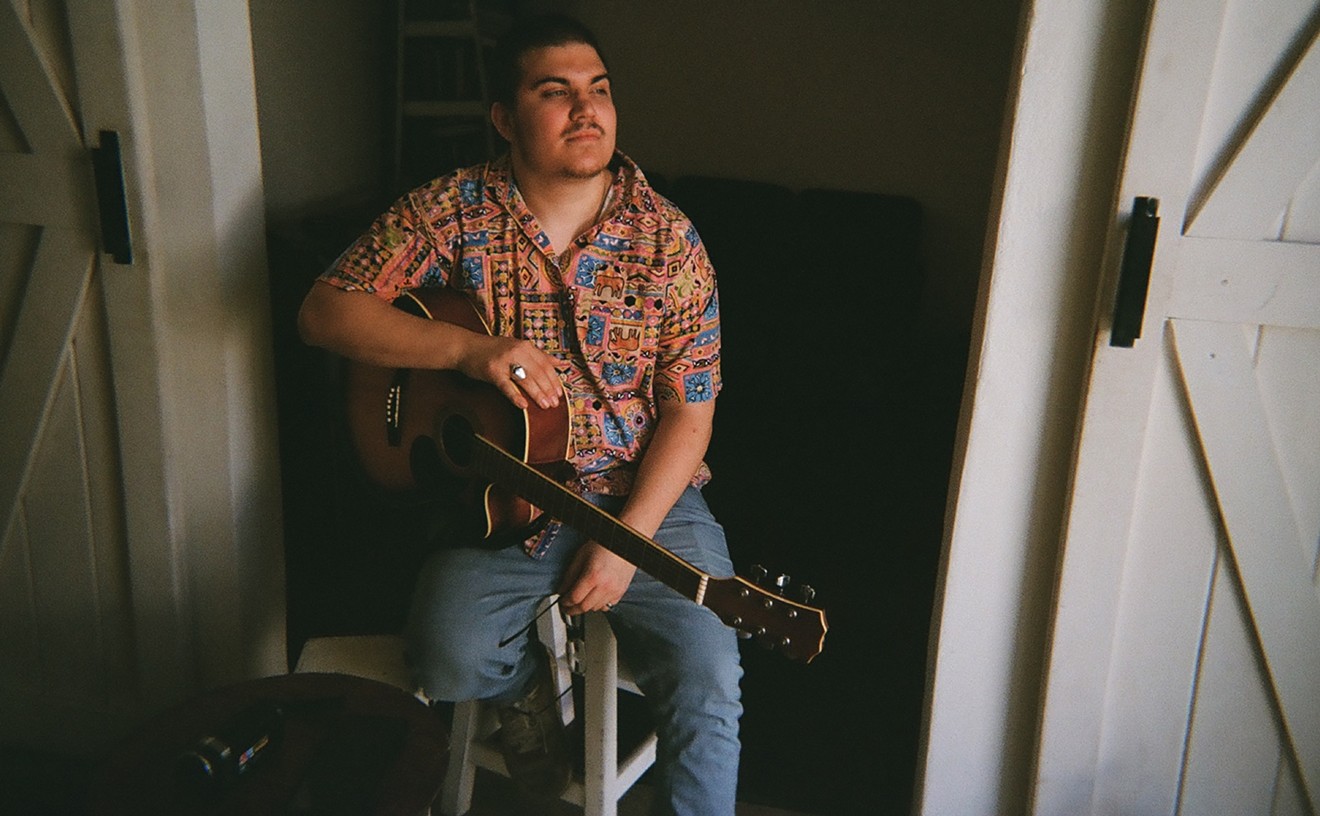Last Sunday, Dawson's family, friends and fellow musicians gathered at the Sons of Hermann Hall to look at old photos of Ronnie, share their memories and say their reluctant farewells. Chris, who Ronnie had once told me "came to my rescue" when they were married in 1996, had chosen to play jazz over the sound system; it was his favorite music, more so than even the rockabilly that made him a legend. Dawson didn't much like funerals, so there wasn't one. Instead, his ashes, collected in an ornate black container, were perched on the stage, in between his acoustic and electric guitars--one last appearance for the Bomber at the Sons, where he had performed dozens of times since his artistic rebirth in the late 1980s.
Below are the liner notes I wrote for the U.S. release of Dawson's 1989 album Rockinitis, the second album he made upon discovering that England still adored him even if America had forgotten about him. Reissued in 1995, it was among several albums he cut in the '80s and '90s, long after his teenage heyday as the crew-cut kid who knocked 'em wild and socked 'em silly at the Big D Jamboree or on the New York-based television show hosted by legendary disc jockey Alan Freed. They were all minor masterpieces of unadorned rock and roll, most made on instruments and with equipment created at the dawn of pop music: 1988's Still a Lot of Rhythm, Monkey Beat in '94, Just Rockin' & Rollin' in '96 and More Bad Habits in '98. These notes have been edited to include some things Dawson said to this paper after the album's release, but they remain in the present tense. It will take more than a little thing like death to make Ronnie Dawson a thing of the past.
Rock-and-roll heroes are hard to come by. They're a myth, actually, because just when you begin to worship an idol they let you down or die. Rock-and-roll heroes are the porcelain figures of the stage--one false step and they shatter into a million pieces, right in front of you.
But there's one man who wears the label with ease, who defines the term with grace--Ronnie Dawson. "You have to go away before you can come back," Dawson once said. These were the words of experience, spoken by a man who went away for decades only to return as a conquering hero well into his 50s. He was a man who seemed to age backward.
Raised in Waxahachie, the Ronnie Dawson of the 1990s is a man only now beginning to receive his due, only now beginning to taste the fame that should have come his way 40 years ago. Dawson, at 56, is a bigger star than he ever was during his so-called heyday of the mid-1950s. He overcame rockabilly's quick rise and even quicker fall to become its greatest champion decades later.
Dawson thought his career over long before most musicians even begin theirs. He was a 16-year-old kid boppin' on the stage of the Big D Jamboree, which was then run by Gene Vincent's--and, for a while, Ronnie Dawson's--manager, Ed McLemore. Dawson took to that stage filled with the cockiness of youth and the pride of the talented. In old photos from the 1950s, Dawson looks like a kid at a talent show, wearing a grown-up's suit and a young boy's smile. He sang congratulations to himself, so sure he was a star.
Dawson scored a fairly big regional hit in 1958 with "Action Packed"/"I Make the Love"--for which he was billed as Ronnie Dee, the teenage boy with a high-pitched voice to match his young age. He then hit the road for tours with Vincent and other lesser-known artists such as Buddy Knox, Gene Summers, Ray Campi and Scotty McKay.
In 1961, Dawson signed to Columbia Records using yet another name. Commonwealth Jones was his moniker, and he was billed as black singer on such songs as "Do Do Do" and "Who's Been Here." He was summarily dropped from Columbia, but eight years later was re-signed to the label by legendary country producer Billy Sherrill, who had Dawson record two more singles for Columbia. He would also play drums on such hits as Paul and Paula's "Hey Paula" and Bruce Channel's "Hey Baby," as well as appear on American Bandstand and Hootenanny. After he was cut loose from Columbia once more, Dawson came back to Dallas and started a country-rock band called Steel Rail, which lasted from 1970 to the early '80s.
Unlike so many of his contemporaries, who aged gracelessly and embraced anonymity by taking mundane day jobs and beginning families, Dawson never abandoned the music business. He merely took refuge in the faceless side of music, working as a studio sideman and recording jingles around Dallas. He'd also get the occasional gig working private parties for corporations, playing '50s rock-and-roll nostalgia for people who had never heard of the Blond Bomber and were uninterested in and ignorant of his past triumphs.
Dawson, had he played by the rules of this game created by and for younger men, should have ended his career there and become a musician for hire--nothing more or less. Then the Cramps covered his version of "Rockin' Bones" on 1981's Psychedelic Jungle, adding just a taste of recognition in the modern rock world. But it was a call in 1986 from Barney Koumis, an English record collector who ran the No Hit Records label, that rescued Ronnie Dawson from the jingle business and obscurity.
Koumis, over a trans-Atlantic phone line, told Dawson his older songs were still getting played in England, where passed-over American music can still find its second and third life. He said there was an untapped market overseas for songs like "Congratulations to Me" and "Action Packed," and he wanted to know if Dawson had any of his other old songs archived so they could be released on a collection abroad.
At first Dawson was skeptical, but finally agreed to the disc that would become No Hit's Rockin' Bones, a collection of the rockabilly idol's earliest songs. Dawson would eventually travel to England to perform; he found himself in a bizarre time warp where rockers still wore their hair slicked back and their women still wore poodle skirts, where tough guys still carried their smokes rolled in the sleeves of white T-shirts and where rockabilly wasn't a lost music but a vital art form. Dawson's career hadn't died, it had just hopped a plane to the U.K.
Throughout the late '80s and early '90s, Dawson began the slow crawl down the comeback path. He released two albums in England, 1988's Still a Lot of Rhythm and 1989's Rockinitis. Still a Lot of Rhythm would see release in the States in 1994 when it was tacked onto the end of Dawson's astonishing Monkey Beat! CD (released first on No Hit, and then picked up for domestic distribution by Dallas' Crystal Clear Sound). The album proved that Dawson was the comeback kid not even into his prime yet, sounding like Jerry Lee Lewis and Gene Vincent action-packed into one eternally young body.
Rockinitis would remain a hard-to-find artifact; its release was vital, as it filled in the gaps and sounded ageless. Those who once dismissed rockabilly as the only pure genre because its flame was extinguished long before it ever roared never heard Ronnie Dawson, never experienced a man whose sound bridges Texas' country blues past and its rock-and-roll future. Dawson's music on Rockinitis--and his other albums, old and new--is rockabilly by way of the blues, embodying the rock tradition and transcending the rockabilly definition.
His music goes back further into the source material and provides a deeper understanding of what made rockabilly such a forceful entity during its brief existence. Dawson knows the verities, he even helped create them, but refuses to acknowledge the expiration date on the side of the carton. The bluesy "Bad Mouthin'," sandwiched between the rave-ups "Knock Down Drag Out" and "The Cats Were Jumpin'," is only one such example of Ronnie's range and the depth of his passion. His voice dips and moans, growls and groans, and he fills in the spaces with a deep guitar sound that was born in the country and defiled in the city.
Many of the songs on Rockinitis survived the record's past obscurity, becoming standards in Dawson's live set. "Shim Sham Shimmy," "The Worryin' Kind" and "Knock Down Drag Out" send the audience swingin' and jumpin' whether they're experiencing Dawson in a renovated old juke joint, a trendy Deep Ellum nightclub or in the middle of a Borders Books and Music outlet (certainly one of his odder gigs in 40-plus years). They are haunting in some places (listen to the guitar on "Rockin' the Cemetery"), jivin' in others (the title track, "Shim Sham Shimmy"), too perfect and powerful to be dismissed as novelty or nostalgia.
Speaking to the Observer, former Blaster and roots-rock purist Dave Alvin offered his most sincere compliments in Dawson's direction: "He's something else," Alvin said. "One of the best shows I ever saw by anyone was Ronnie Dawson. Forget it. That was the best rockabilly show I ever saw, and it's in the top 10 of all-time best shows I ever saw. You had that feeling that this is exactly what it friggin' felt like then, and this is exactly what it sounds like now."
And therein lies the perfect description of Ronnie Dawson--a man for whom time stood still, even if he has not. He's as timeless as his music, no wax work in a rock-and-roll mausoleum but a living embodiment of all that was good about rock and roll in its infancy and all that is great about it 40 years later.
Above Ronnie and Chris Dawson's fireplace hangs an enormous yellow-and-black poster advertising a show featuring Dawson and Carl Perkins. Dawson says he keeps it there to remind himself of his place in rock-and-roll history: "Below Carl Perkins," he says, not at all joking. Yet where Perkins and Gene Vincent and their lot backed themselves into a corner in 1956, Dawson moves forever forward. And to think that when he was a child growing up in Oak Cliff, he never even wanted to perform in public. It wasn't until a friend forced him to, during a Future Farmers of America talent show, that Dawson discovered what he'd end up doing for the rest of his life.
"I was a sophomore, and I'd just play at home," Dawson says, recounting a story he seldom tells. "I was bashful. My buddies knew I could play, and they went by my house and got my guitar and took it to school. The teacher said, 'We got a guy here, and somebody said he could play gee-tar. I don't really think he can.' I looked up there, and it was my guitar. I was on the spot, and I had to play, and when I did, I went crazy. I never said anything to anyone. I went to school and walked next to the walls and did my work. That was when it started."










